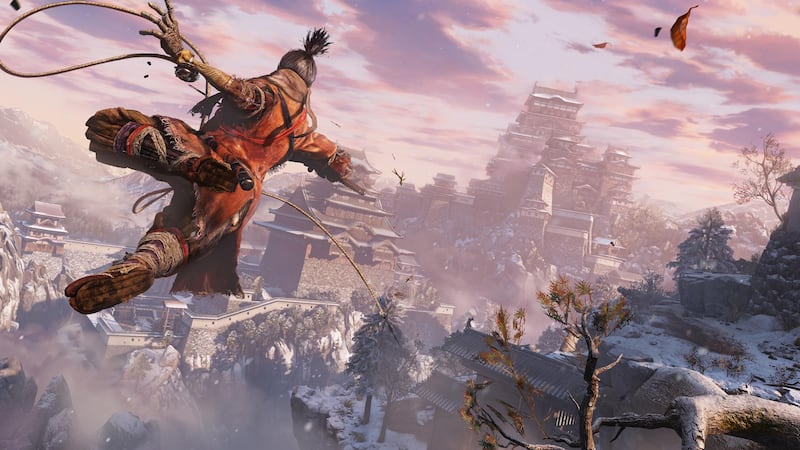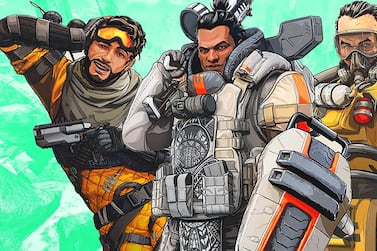We have a first try of 'Sekiro' and then delve deeper into the mind of Miyazaki...
The game review: what it's like to play 'Sekiro'
Sekiro: Shadows Die Twice, which releases on March 22, is something of a homecoming for FromSoftware. Set in a late 1500s Japan reimagined with Miyazaki's fine eye for dark fantasy, Sekiro puts players in the shoes of the "one-armed wolf", a warrior on a quest for revenge. In your way stand an army of foes.
As much as Sekiro is a game in the Dark Souls mould, there are some significant changes. There is the new setting, yes, but that's only part of it. The gameplay has been changed up significantly. One of the biggest changes is the addition of a dedicated jump button and a much greater focus on verticality in how you approach enemy encounters – fitting, for a ninja.
As the game's title suggests, Sekiro continues to play with how death works in video games. As in Dark Souls, death is not the end here, and can even be used tactically. But dying can be more costly than in was in earlier games, and has more long-lasting consequences for your character than it does in Dark Souls.
Another change is having a defined protagonist. In Dark Souls, you created your own character, choosing your name, your look, and your starting abilities and skill points. You could choose to play as a melee combat specialist, or put all your effort into becoming a powerful sorcerer that picks enemies off from afar.
In Sekiro, you are the one-armed wolf. You still make choices that affect the course of the game and can adapt your fighting style, but it's not as open-ended as Dark Souls. This is not a value judgment, however – it's simply different than what came before. And it allows a greater focus on storytelling, much as The Witcher series is capable of accomplishing the same by having you play as a pre-existing character, rather than letting you create your own from a blank slate.
The biggest change is the combat, which is a revelation. FromSoftware came up with an ingenious solution to a problem that’s always been at the heart of action games of this type: how do you make combat both exciting and realistic when you’re depicting people fighting with swords?
The most common solution is to just give the player and enemies a health bar that needs to be whittled away. The result is that you usually end up having to deliver numerous strikes that would be deadly in real life only to take away a little bit of an enemy's health. Sekiro doesn't dispense with the health bar, but it plays a much less important role in combat.
In Sekiro, combat is all about what the game calls "posture", similar to "poise" in the Souls games, but much more important here. You and your enemies both have a posture bar, which fills slightly every time you block or deflect an attack with your sword. The goal is to break an enemy's posture. It's a lot closer to what a sword duel would look like in real life than anything usually seen in games.
Battles are frantic and strategic at the same time, as you try to break your opponent’s posture by keeping up the pressure while defending against his attempts to do the same to you. It makes every encounter, even against the lowest-level enemy, very exciting. Hitting that finishing move after breaking your opponent’s poise is very satisfying and addictive – and quite bloody (this is not a game for children).
But to survive all but the earliest and easiest encounters, you’re going to have to – you guessed it – get good at fighting. As in FromSoftware’s earlier games, the road to victory is never paved with button mashing. Concentration, reflexes and tactical thinking are required. Pressing the attack is essential to breaking enemies’ posture, but patience and discretion are essential virtues. When you’re faced with a particularly difficult opponent, there are no shortcuts. Study his or her moves, get better at your own, and try again.
Understandably, this is not everyone's idea of a good time. Despite their popularity, Miyazaki's games remain a relatively niche pastime – at least in terms of the number of players who will manage to successfully complete a Souls game (there are millions of people who prefer to watch other, better gamers play through these games instead).
Completing a game like Sekiro feels like a true achievement. Anyone who manages to do so will have put in a lot of time and effort. It's a test of patience, of your ability to handle frustration and stay calm under pressure, as much as – no, in fact more than – your ability with a controller.
In a world of ever-more-instant gratification and cheaper thrills masquerading as something more, Miyazaki and FromSoftware stand for something else. Long may they continue to inspire us to git gud.
What's 'git gud' you ask?
“Git gud.” This is the response many a gamer has received after being destroyed in a multi-player contest, or when asking players for advice getting past a particularly difficult boss battle in a single-player game.
A deliberate misspelling of “get good”, it’s simultaneously an insult and an exhortation to strive for excellence. It’s an attitude that has no time for ineptitude, but then all of the time in the world for those willing to try and improve their skills.
Around since 2008, the phrase soared in popularity and cultural relevance with the rise of FromSoftware's Dark Souls, released in September 2011. Dark Souls quickly became a phenomenon, with its reputation for difficulty, a mysterious setting, bare-bones storytelling and a lack of hand-holding.
Game director Hidetaka Miyazaki was showered in deserved praise for upending expectations of just what sort of game could be successful in this day and age.
Why games became easier when they went from arcade to living room
To understand the success of Dark Souls and the rise of git gud-ism, it's necessary to know a bit of gaming history. Once upon a time, in the dark (or at least dimly lit) lands known as arcades, games had high difficulty levels not purely for artistic consideration but also for financial purposes: each time you failed to clear a level, you had to put another coin in the slot to continue.
As gaming moved into the living room and on to games consoles and desktop PCs, things started changing. The earliest home games were direct arcade ports, and maintained the difficulty of the arcade originals sans the need to pay to play.
Over time, improvements in graphics and other hardware made it possible to tell ever-more complicated and life-like stories as the industry tried to reach “Hollywood-level” realism and immersion.
Freed from the constraints of the arcade model, developers were also freed to make games with lower difficulty levels. Fast-forward to circa 2010, and most of the top-selling games were not difficult to complete.
Instead of inserting challenges of the sort that would prevent most players from progressing, developers seemed more intent on ensuring that all but the most hopeless of players would be able to make it to the end of a single-player campaign or story (all bets were off in the multiplayer world, where git gud was the reigning philosophy long before the term was coined).
Why, after all, put all that effort into a crafting a grand tale playing out in painstakingly designed environments meant to wow audiences, if only a fraction of people were going to get a chance to experience it all? Did you get shot in a first-person shooter? Forget health packs – they're so late 90s. Now, you simply recovered hiding in a corner for a while and not taking any more damage. If you somehow still ended up dying all the time, well, there is always the option to turn the difficulty down even more.
Still not enough? Go online and find a bevy of walkthroughs and guides, and if those don’t have the answers you seek, ask for advice on an online forum.
But then 'Dark Souls' made things tricky again
It was into this world that Dark Souls strode. Forget about being gently guided around a familiar world and made to feel like a superhero without much effort – Dark Souls prided itself on just how often the words "you died" appeared on the screen. More than prided itself, dying was an integral part of the game.
In Dark Souls, death is not the end. Your character respawns at the last bonfire your rested at, but without all the "souls" (experience points used to level up your skills and abilities) and humanity (it gets complicated) you were carrying. If you manage to get back to the spot you were killed without dying again, you can recover your lost loot. But if you die again, it's gone for good. Death is never permanent, however, you can keep trying again and again.
Older players quickly spotted how this was in many ways a throwback to the games of yore: ones that challenged you to get good enough to pass a level and that did not feel compelled to give you easy ways to defeat a big boss or make it through a particularly challenging level.
This approach resonated with many gamers, young and old. They enjoyed being given a challenge, enjoyed the sense of accomplishment that came with finally vanquishing a difficult boss on the 29th attempt and after several hours of failing. They enjoyed having to “git gud”.
Dark Souls quickly became famous for its difficulty, but also for its world, best described as a medieval European fantasy-horror setting as filtered through the eyes and minds of a Japanese development team.
It is a world filled with secrets and dense with hidden clues about current events, and ones that played out centuries ago. Everything – the art, sound and level design, architecture and music – contributed to creating an incredible sense of place.
One sign of the success of Dark Souls was how it quickly inspired other games in trying to follow or borrow from the same formula. Another was the proliferation (to the point of eventual inanity) in the gaming press of the phrase "the Dark Souls of [insert genre here]" to refer to new games that had even a hint of difficulty.
Dark Souls II was released in 2014, and while not as well received as its predecessor, it does retain a devoted fanbase. A year later, Miyazaki and co unleashed Bloodborne on the gaming world, a Playstation 4 exclusive that answered the question of what Dark Souls would have been like if it had been set in a Victorian-era city. It brought to the Souls series a focus on more aggressive gameplay, faster combat and a healthy dollop of H P Lovecraft-inspired cosmic horror.
Dark Souls 3, released in 2016, was a return to the medieval Gothic of the main series, and completed the Dark Souls trilogy. Fans then started asking what Miyazaki would do next. Perhaps something related to Demon's Souls, the spiritual predecessor to Dark Souls? The answer was unexpected: Sekiro.







